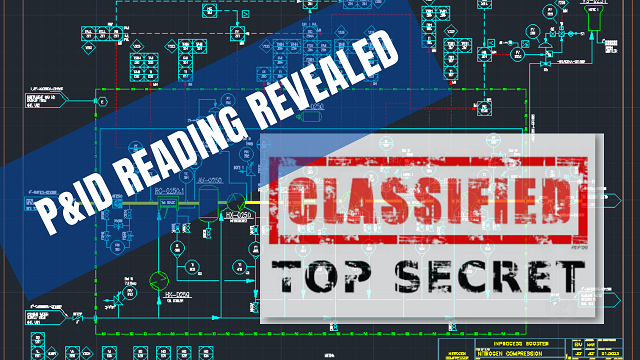START READING P&ID TODAY
Reading the Piping and Instrumentation Diagram (P&ID) is one of the most BASIC SKILL that every chemical process engineer must have to. It does not matter if you work with the operation, process safety or plant design, If you do not know how to read a P&ID, you are in trouble.
On the other hand, no one born knowing what is a P&ID and for sure, most people do not need to know what it is or what it does. In other words, you need to develop this skill.
I was not different from you, I did not learn reading P&ID in my chemical engineering course (Bachelor). First, maybe because my teachers did not have experience in plant design, they did not know or were not interested in doing a relationship between the academic world and the job market. Second, probably because I did not have easy access to this kind of document and I did not know how important it would be to work with plant design.
Although I do not know what exactly is your case, I am here to help you fix it. With the following tips, you will be able to start reading P&ID and in the near future how to develop them.
PIPING AND INSTRUMENTATION DIAGRAM (P&ID)
At its first sight piping and instrumentation diagram or process and instrumentation diagram how some people like to call P&ID (there are other names also) may be very intimidating. More complex the Process, more line, more numbers, more symbols etc you will have in a P&ID. However, once you identify keep features in the drawing, it gets easier to know what is “happening”. This manner I will share with you 3 things you should do when you need to read a P&ID.
FOLLOW THE FLAGS
Every time you get a new P&ID in your hand start identifying the flags the go in and that goes out from the drawing. Do that because the P&ID represents an industrial process with a starting point, a series of processes and one or many ending points. For instance, the starting point can be the raw material supply or utilities. They come from somewhere and need to enter the drawing. The ending point in your turn can be the product, vent, drains or wastes. This way, the raw material gets into the process, and the product and nonproducts need to be sent somewhere.
It is common to have the entering flags at the left side of the P&ID sheet and the going out flags at the right side. Stay alert also to the arrows on the streams because they show you fluid direction.
PIPE NUMBERING
Unless you are working in mining or in a process based on solid processing like aluminum production where stream transportation is done by conveyor belts, you need to be familiar with piping systems. This system is essential to connect liquid and gas streams from one point to another and it is very common in the oil and gas industry, air separation process and many other chemical, petrochemical etc industrial plants.
Because of its importance, the piping system is identified in the P&ID in order that designers are able to correctly choose materials, fitting, etc for design.
The most common way of pipe numbering or identification is by adding to them its size, operational area, fluid service, sequential number, pipe material, and flange pressure rating and in some cases, pipe insulation is also informed. Although it will vary from one company to another, this kind of numbering structure is very similar and you will be able to understand important info from the stream represented in the P&ID based on the pipe numbering.
For instance, take a look at the pipe 10”-CWS-8007-SS600-1”. In this case, and with the help of a table of legends, we could find that this pipe has 10” size, its service is Cooling Water Supply, i. e., it is cooled water before passing through heat exchangers for temperature transfer, operating area 80 (cooling water distribution), sequential 07 (probably exist at least 6 pipes designation before pipe 07), stainless steel as pipe material, flange pressure rating of 600# and insulation of 1” thickness.
As you can see, understating a pipe number can review a lot of information. And some of them have a direct influence on process simulation.
INSTRUMENTATION SYMBOLS AND DESIGNATION
Once you know where the process starts and where it ends, which kind of fluid is in the process and what is the pipe information, it is a good time to care about the instrumentation. Here I include not only instruments like manometer, thermowell, orifice plate etc but and also control valves. Although you can identify and understand the control system of a P&ID once you master reading, the correct path is to, once again, consult the table of legend and symbols for instruments and control, similar as you did for piping numbering.
A very well know reference for that is the ISA (International Society for Automation) Identification letters and symbols shown on ISA 5.1 Instrumentation Symbols and Identification. Many companies use that as a reference and eventually, one or another function will not be related to ISA table.
With the mentioned table of letters and symbols, you will be able to identify the function of instruments and control valves and identify also the control system. For instance, a box Identified as PIC-8007 connected by dashed lines to a valve identified as PV-8007. This is a control loop and means that exists a control system where an electrical signal is sent to PIC and based on its inputs a signal will be sent to the valve for opening or closing.
WHAT´S NEXT
At this time, only worry about identifying what each designation means. In the future, I will return to talk about process control. In any case, you can get further in P&ID reading and understanding taking a look at the 2 post links I will let for you below.
Of course, there is much more to be said about P&ID reading, however, I believe that these 3 tips are a good start to you begging reading a P&ID today.
How To Identify Monitoring and Pressure Control In A P&ID
What is P&ID: PIPING and Instrumentation Diagram or PROCESS and Instrumentation Diagram?
INPROCESS BOOSTER P&ID – LEARN HOW TO READ AND DEVELOP P&ID TODAY
FIND MORE ABOUT READING PIPING AND INSTRUMENTATION DIAGRAM
In this video, I do an overview of what was said in this post and also give you more info and examples using real cases. Moreover, I will tell you how to download a table of symbols and designation in order that you can practice P&ID reading.
MY FREE MENTORING CHANNEL AND OTHER SOCIAL MEDIA
INPROCESS Telegram channel at https://www.jefersoncosta.com/inprocess
THE CHEMICAL PROCESS ENGINEER AND PLANT DESIGN at YouTube
FAN PAGE on Facebook at https://www.facebook.com/inprocessbooster
Connect with me in LinkedIn at https://www.linkedin.com/in/jeferson-costa-process-engineer




